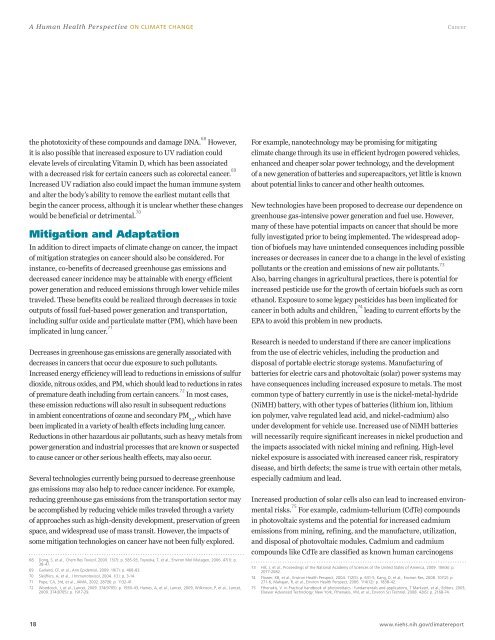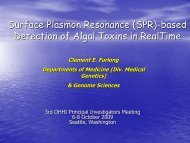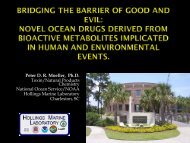A Human Health Perspective On Climate Change - The Oceans and ...
A Human Health Perspective On Climate Change - The Oceans and ...
A Human Health Perspective On Climate Change - The Oceans and ...
You also want an ePaper? Increase the reach of your titles
YUMPU automatically turns print PDFs into web optimized ePapers that Google loves.
A <strong>Human</strong> <strong>Health</strong> <strong>Perspective</strong> ON CLIMATE CHANGECancerthe phototoxicity of these compounds <strong>and</strong> damage DNA. 68 However,it is also possible that increased exposure to UV radiation couldelevate levels of circulating Vitamin D, which has been associatedwith a decreased risk for certain cancers such as colorectal cancer. 69Increased UV radiation also could impact the human immune system<strong>and</strong> alter the body’s ability to remove the earliest mutant cells thatbegin the cancer process, although it is unclear whether these changeswould be beneficial or detrimental. 70Mitigation <strong>and</strong> AdaptationIn addition to direct impacts of climate change on cancer, the impactof mitigation strategies on cancer should also be considered. Forinstance, co-benefits of decreased greenhouse gas emissions <strong>and</strong>decreased cancer incidence may be attainable with energy efficientpower generation <strong>and</strong> reduced emissions through lower vehicle milestraveled. <strong>The</strong>se benefits could be realized through decreases in toxicoutputs of fossil fuel-based power generation <strong>and</strong> transportation,including sulfur oxide <strong>and</strong> particulate matter (PM), which have beenimplicated in lung cancer. 71Decreases in greenhouse gas emissions are generally associated withdecreases in cancers that occur due exposure to such pollutants.Increased energy efficiency will lead to reductions in emissions of sulfurdioxide, nitrous oxides, <strong>and</strong> PM, which should lead to reductions in ratesof premature death including from certain cancers. 72 In most cases,these emission reductions will also result in subsequent reductionsin ambient concentrations of ozone <strong>and</strong> secondary PM 2.5, which havebeen implicated in a variety of health effects including lung cancer.Reductions in other hazardous air pollutants, such as heavy metals frompower generation <strong>and</strong> industrial processes that are known or suspectedto cause cancer or other serious health effects, may also occur.Several technologies currently being pursued to decrease greenhousegas emissions may also help to reduce cancer incidence. For example,reducing greenhouse gas emissions from the transportation sector maybe accomplished by reducing vehicle miles traveled through a varietyof approaches such as high-density development, preservation of greenspace, <strong>and</strong> widespread use of mass transit. However, the impacts ofsome mitigation technologies on cancer have not been fully explored.68 Dong, S, et al., Chem Res Toxicol, 2000. 13(7): p. 585-93, Toyooka, T, et al., Environ Mol Mutagen, 2006. 47(1): p.38-47.69 Garl<strong>and</strong>, CF, et al., Ann Epidemiol, 2009. 19(7): p. 468-83.70 Sleijffers, A, et al., J Immunotoxicol, 2004. 1(1): p. 3-14.71 Pope, CA, 3rd, et al., JAMA, 2002. 287(9): p. 1132-41.72 Woodcock, J, et al., Lancet, 2009. 374(9705): p. 1930-43, Haines, A, et al., Lancet, 2009, Wilkinson, P, et al., Lancet,2009. 374(9705): p. 1917-29.For example, nanotechnology may be promising for mitigatingclimate change through its use in efficient hydrogen powered vehicles,enhanced <strong>and</strong> cheaper solar power technology, <strong>and</strong> the developmentof a new generation of batteries <strong>and</strong> supercapacitors, yet little is knownabout potential links to cancer <strong>and</strong> other health outcomes.New technologies have been proposed to decrease our dependence ongreenhouse gas-intensive power generation <strong>and</strong> fuel use. However,many of these have potential impacts on cancer that should be morefully investigated prior to being implemented. <strong>The</strong> widespread adoptionof biofuels may have unintended consequences including possibleincreases or decreases in cancer due to a change in the level of existingpollutants or the creation <strong>and</strong> emissions of new air pollutants. 73Also, barring changes in agricultural practices, there is potential forincreased pesticide use for the growth of certain biofuels such as cornethanol. Exposure to some legacy pesticides has been implicated forcancer in both adults <strong>and</strong> children, 74 leading to current efforts by theEPA to avoid this problem in new products.Research is needed to underst<strong>and</strong> if there are cancer implicationsfrom the use of electric vehicles, including the production <strong>and</strong>disposal of portable electric storage systems. Manufacturing ofbatteries for electric cars <strong>and</strong> photovoltaic (solar) power systems mayhave consequences including increased exposure to metals. <strong>The</strong> mostcommon type of battery currently in use is the nickel-metal-hydride(NiMH) battery, with other types of batteries (lithium ion, lithiumion polymer, valve regulated lead acid, <strong>and</strong> nickel-cadmium) alsounder development for vehicle use. Increased use of NiMH batterieswill necessarily require significant increases in nickel production <strong>and</strong>the impacts associated with nickel mining <strong>and</strong> refining. High-levelnickel exposure is associated with increased cancer risk, respiratorydisease, <strong>and</strong> birth defects; the same is true with certain other metals,especially cadmium <strong>and</strong> lead.Increased production of solar cells also can lead to increased environmentalrisks. 75 For example, cadmium-tellurium (CdTe) compoundsin photovoltaic systems <strong>and</strong> the potential for increased cadmiumemissions from mining, refining, <strong>and</strong> the manufacture, utilization,<strong>and</strong> disposal of photovoltaic modules. Cadmium <strong>and</strong> cadmiumcompounds like CdTe are classified as known human carcinogens73 Hill, J, et al., Proceedings of the National Academy of Sciences of the United States of America, 2009. 106(6): p.2077-2082.74 Flower, KB, et al., Environ <strong>Health</strong> Perspect, 2004. 112(5): p. 631-5, Kang, D, et al., Environ Res, 2008. 107(2): p.271-6, Mahajan, R, et al., Environ <strong>Health</strong> Perspect, 2006. 114(12): p. 1838-42.75 Fthenakis, V in Practical h<strong>and</strong>book of photovoltaics : fundamentals <strong>and</strong> applications, T Markvart, et al., Editors. 2003,Elsevier Advanced Technology: New York, Fthenakis, VM, et al., Environ Sci Technol, 2008. 42(6): p. 2168-74.18 www.niehs.nih.gov/climatereport










